Menu
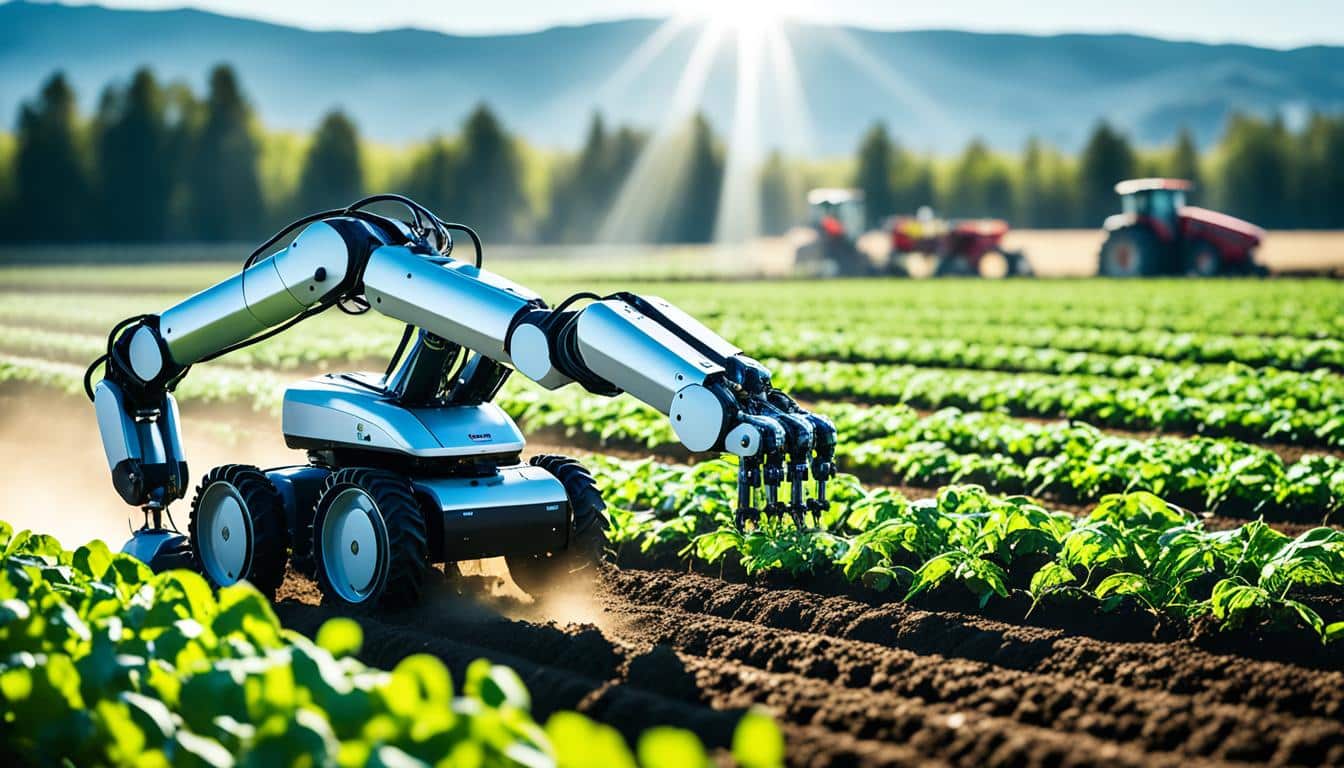
Using robots to harvest crops can boost efficiency by 70%. This big change is thanks to robotic farming tech. It uses machines like harvesting robots with high-tech sensors and cameras. These machines pick crops with great accuracy.
Robots are also tackling weeding jobs. They use advanced tech to spot and get rid of weeds better than humans. This is a big step in making farming more automatic. It helps fight against not having enough workers and feeds the world in a better way.
The future of farming is clearly with robotic tech. It’s not just about doing more work better. It’s also about cutting down waste. Machines are leading us into an exciting time for farming. It’s all about doing things more efficiently and in ways that keep our planet healthy.
Farm robotics are changing the game in agriculture, boosting efficiency and productivity. With a 60% increase in global crop demands expected by 2050, our farming methods must adapt. Farm robotics lead this change, ready to transform modern agriculture.
Farm robotics are unmatched in their efficiency, taking over tasks that used to need a lot of people. They can keep working without stopping, significantly raising productivity. For example, robots designed for precision farming can spot and pick crops accurately, cutting down waste and improving yields.
The value of the global agricultural robot market topped $43 billion in 2021. It’s on track to exceed $81 billion within the next eight years. This growth shows how crucial these autonomous machines are becoming for keeping up with work, especially as labour costs increase and farm workforces shrink.
Farm robotics offer a smart fix to the labour problems in agriculture. Over half of all farmers face a shortage of workers, and labour costs make up half of their expenses. By using robots, farms can work better without having to rely solely on human hands.
Robots in agriculture also help save water and support sustainability. Studies show that with robots, we can grow crops using up to 90% less water, which is more than 20 times more efficient. This big focus on using resources wisely fits into the agriculture industry’s aim to cut down on chemicals and greenhouse gases.
Swarm technology is making robotic farming even more innovative, creating new ways to work better. Looking ahead, precision farming robots and other autonomous equipment will play a key role in meeting agriculture’s ongoing and future challenges.
The table below lists some of the key advancements and numbers in farm robotics:
| Year | Market Value | Spending on Robotic Farming |
|---|---|---|
| 2021 | $43 billion | $6 billion |
| 2028 | $81 billion | $18 billion (projected 2030) |
AI is changing agriculture in big ways. It’s making farming more efficient and productive. With the world’s population set to reach 10 billion by 2050, farms need to produce more. AI is helping by making smart decisions based on data to boost output.
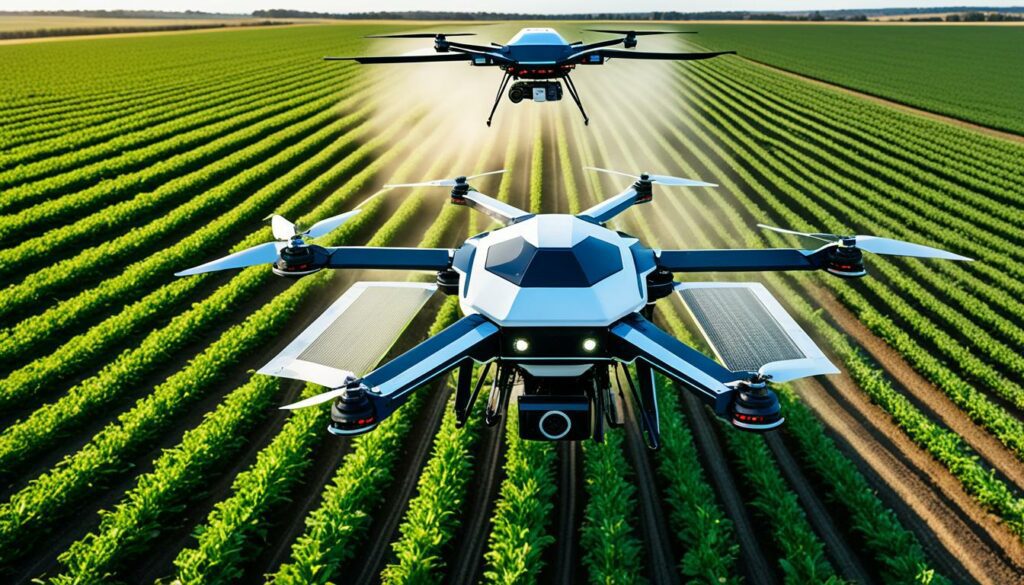
AI shines when it comes to spotting crop diseases. It can do so with over 90% accuracy. Take apple trees, for example. AI systems using image data can identify their diseases 95% of the time. And, in wheat fields, AI is excellent at finding yellow rust in crops from images. This means healthier plants and less need for pesticides.
AI also powers machines that work by themselves on the farm. Drones and robots do tasks more precisely than people, saving on resources. They’re really good at making sure crops get just the right amount of water. This cuts down water waste. Adding smart sensors to the mix makes water use even more efficient, which is great for the planet.
When it comes to managing weeds, AI is a winner too. Automatic weed fighters can reduce herbicide use by a huge 90%. This is a big step towards using fewer chemicals. AI also helps keep an eye on the health of cows. Tools like CattleEye find diseases early, which helps with feeding the animals better.
AI’s skills don’t stop there. It can predict when it’s the best time to harvest or fertilise. By looking at soil and weather data in real time, AI helps make farming smart and profitable. This is good for the farmers and the consumers.
With AI, agriculture is becoming smarter, greener, and more productive. The AI market for farming is expected to grow a lot, more than doubling from USD 1.7 billion in 2023 to USD 4.7 billion by 2028. This shows how powerful and essential AI is becoming in agriculture.
Agricultural robotics now features more than just the old machines. It includes six-axis robots, mobile robots, and autonomous tractors. These new technologies help farms function better and more efficiently.
Six-axis robots are key in harvesting for their great precision and agility. For example, Tortuga AgTech has made autonomous robots that are up to 98 percent accurate in picking fruit. This reduces the need for a lot of people to watch over the process.
FFRobotics, on the other hand, is working on a fruit harvester that’s set to be much faster than manual picking. It uses computer vision to spot and pick the ripest fruit. These innovations increase the speed of harvesting, raise productivity, and lower the cost of labour.
Mobile robots are also making big changes in agriculture. Take the Scythe Robotics’ M.52 mower, for example. It uses AI and sensors to move easily around things.
Naio Technologies has developed robots for weeding, cutting down on weedkillers. Nexus Robotics’ R2Weed2 is even smarter, using AI to tell crops from weeds. This helps in removing weeds and learning important things about the soil.
Autonomous tractors are changing the farming game, ensuring work goes on 24/7. AppHarvest uses these advanced tractors for precise farming and spreading fertiliser. This leads to better use of resources and more crops.
These tractors can do planting, fertilising, and other key tasks without needing people around all the time. This shows just how much impact autonomous farming tools can have on agriculture today.
Robotic harvesting has changed the way we pick crops. These robots are designed to be precise. They pick crops carefully to avoid damage. They use special grips and sensors to check if the crop is ripe.
Robotic harvesting technology is very good at being precise. They use six-axis robots that can stay in one place to pick fruits and vegetables. These robots work with mobile parts to reach more crops. This use of technology has made harvesting more efficient and accurate than before.
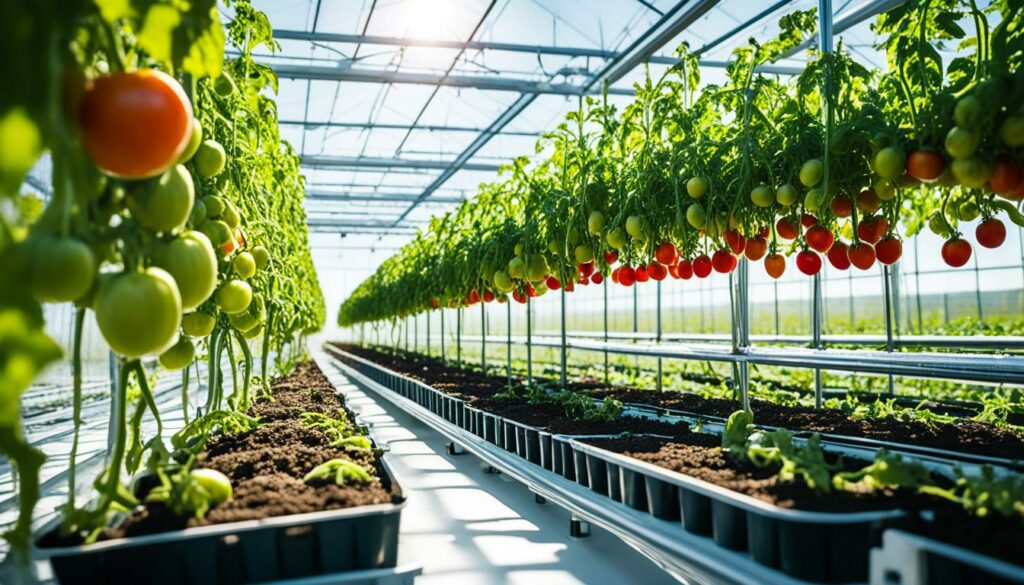
Robotic harvesters have many benefits over old ways of harvesting. They cut down on the number of people needed to pick crops. For example, a robot picking strawberries can work over a big area in a short time. It could do the job of 30 people.
These robots help farming be better for the environment. They are precise, which lowers waste. They also spread nutrients in the soil evenly. This makes farming more eco-friendly.
The table below highlights some of the key differences between traditional and robotic harvesting methods:
| Method | Efficiency | Labour Requirement | Produce Damage |
|---|---|---|---|
| Traditional Harvesting | Moderate | High | High |
| Robotic Harvesting | High | Low | Low |
As more people need food, the use of these robots will grow. They are making gathering crops better and more reliable. These robots are changing how farms work and are becoming very important for the future of farming.
Weeding robots have changed how we farm by using advanced robotic tech. This tech cuts down on the need for people to do hard manual work. An example is the LaserWeeder by Carbon Robotics. It has got more than $80 million in support. This shows a big move to farming in ways that are better for our planet and work smarter.
Some worry about the effect of using chemicals to kill weeds. These worries include water pollution and harm to wild plants and animals. Weeding robots offer a better choice, slashing the use of weed killers by 90%. For example, Blue River Technology’s “See & Spray” sees what is a crop and what is a weed. It then sprays only the weeds without harming the crop. This saves on chemicals and protects the environment.
Getting rid of weeds by hand takes a lot of time and hard work. But, adding robots to the farm like Robovator from F. Poulsen Engineering speeds things up. They pull out weeds without hurting the environment like chemicals do. These smart robots can tell plants apart and work well no matter the weather.
Robots do the weeding super quickly and with great skill, as fast as we blink. They learn and get better using AI. This is why they are so good at spotting weeds. An awesome example is FarmDroid’s FD20. It uses very little tech and runs on sun power. This helps save energy and is kinder to the Earth.
| Company/Product | Funding Raised | Benefits |
|---|---|---|
| Carbon Robotics’ LaserWeeder | $80 million | Minimises herbicide usage by 90%, enhances weeding efficiency |
| Blue River Technology’s “See & Spray” | Not disclosed | Precision targeting of weeds, significant chemical reduction |
| FarmDroid FD20 | Not disclosed | Solar-powered, reduces energy consumption, lower maintenance costs |
These robotic helpers mark a big change in how we farm. They help us grow food in ways that are good for the earth and very accurate. Whether it’s high-tech seeing or easy-on-the-tech robots, they all are making farm life better.
Modern farming has changed a lot with the use of seeding and planting robots. These machines use GPS to plant seeds very accurately. This helps crops grow well and gives better harvests. Thanks to these tools, farming is becoming more efficient and productive than ever before.

The use of GPS in farming makes seeding and planting robots very precise. They can plant seeds in the right place and right depth with the help of GPS and sensors. This careful planting means less waste and better use of farm land. As a result, farms can produce more food in a sustainable way.
| Company | Technology | Benefit |
|---|---|---|
| Tortuga AgTech | 98% accuracy in fruit picking | Minimises crop damage |
| Harvest Automation | HV-100 robot | Operates in extreme temperatures |
| Carbon Robotics | Laserweeder | Selectively removes weeds |
Autonomous planting is a big step forward in farm automation. This method helps farmers plant in a big, efficient way. It makes sure crops grow evenly. This lets farming move away from manual work to more important jobs on the farm.
Robots can now plant precisely and adapt to different farm conditions. They make sure planting is perfect on all kinds of land.
Farms today use agricultural robotics to spread fertilisers more accurately. This ensures nutrients go exactly where needed. It cuts down on waste and helps the environment.
These high-tech fertilising solutions are getting more common. They make sure the right amount of fertiliser is used, avoiding waste. Machines like harvesting robots and planting robots make farming faster and more effective.
Let’s look at how traditional fertilising methods compare to robotic ones:
| Traditional Fertilising | Robotic Fertilising |
|---|---|
| Manual application | Automated precision |
| High labour costs | Reduced labour costs |
| Wastage of nutrients | Minimised waste |
| Inconsistent fertilisation | Consistent application |
Using these smart technologies doesn’t just make farming better. It also helps the planet. With more and more advances in farming robots, we’re moving towards a sustainable future.
Robotic technology has changed how farms work today. Mobile agricultural robots are now a key part of farming. They help farmers watch over their crops and move through fields on their own.
Mobile agricultural robots shine in keeping an eye on crops. They use sensors and cameras to track soil moisture and plant health. This helps farmers to act quickly, making their crops better and healthier.
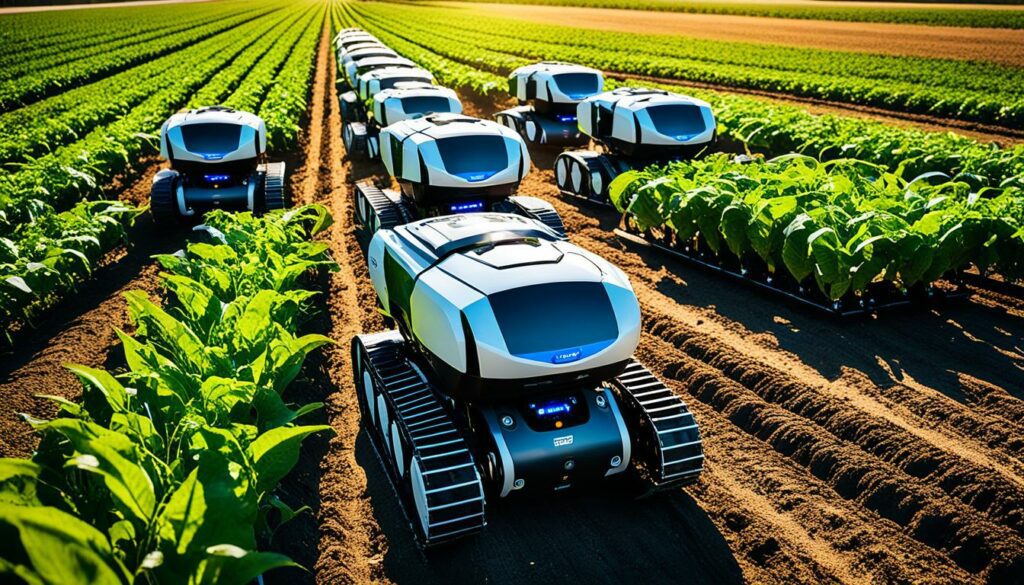
These robots are also great at moving around fields without help. They can do planting, weeding, and fertilising precisely. This means less work for humans and fewer mistakes.
Sending money on robotic farming went over $6 billion in 2022. It’s expected to reach $18 billion by 2030. With support from groups like the European Union and the UK, these robots keep getting better. The goal is farming that uses less, is eco-friendly, and meets food needs worldwide.
Autonomous tractors are now key in agricultural automation, changing the game with non-stop operation. Before them, farming stuck to old ways for 2,000 years. Now, modern gear takes us forward without tiring, even when workers are scarce.
Being able to work round the clock is a major plus for these tractors. They don’t need rest like people do, pushing farm hours and output up. Day or night, tasks like ploughing go on, helping keep prices down thanks to fewer worker needs.
Autonomous tractors are all about doing things the same way every time. They lock onto gps and sensor info, moving and avoiding obstacles spot-on. Safety systems and smart tech cut down on mistakes, upping field precision and cutting costs. This all helps farms grow more for less.
The market for these tractors is set to keep growing, showing we want more high-tech machines. Just look at models like the John Deere 8R 410, known for seeing every obstacle, and the Fendt 1000 Vario, great at handling tough ground on its own. These examples prove these machines are both versatile and hard-working.
The following table compares notable autonomous tractors available in the market:
| Model | Year | Horsepower | Special Features | Price Range |
|---|---|---|---|---|
| John Deere 8R 410 | 2021 | 177 to 405 | 360-degree obstacle detection, stereo cameras | $500,000 – $800,000 |
| CNH Industrial New Holland T7.315 | 2020 | n/a | Lidar and radar sensors | n/a |
| Fendt 1000 Vario | n/a | 112 to 517 | Autonomous tilling, soil work on slopes | n/a |
| Monarch Tractor MK-V | 2023 | 250 | Battery-operated, fully electric | $50,000 |
| Yanmar YT5115N Prototype | n/a | n/a | Lidar and stereo cameras for navigation | n/a |
To wrap up, the shift to autonomous farm tech is turning farming into a new era. It’s all about more exact work, better efficiency, and higher yields.
Trends in agricultural automation now focus on being green and tight on budget. This shift comes as costs like fertilisers and pesticides have shot up by 80 to 250 percent worldwide. The industry also faces challenges with finding enough workers and tackling environmental issues. So, solutions that promote sustainable farming are key.
Integrating green tech isn’t just about helping the planet. It’s also about boosting the money farms make. For instance, automated farming in orchards and vineyards can earn farmers over $400 more per acre every year. This makes a big difference for their profits. Similarly, in vineyards, using automation can add between $200 and $800 in value for each acre.
This shows that technology is not only helpful but vital for sustainability and success. Additionally, automated methods have cut herbicide use by 80 percent on US corn farms. As a result, they’ve saved 93 million gallons of these chemicals each year. This is both good for the environment and the bottom line.
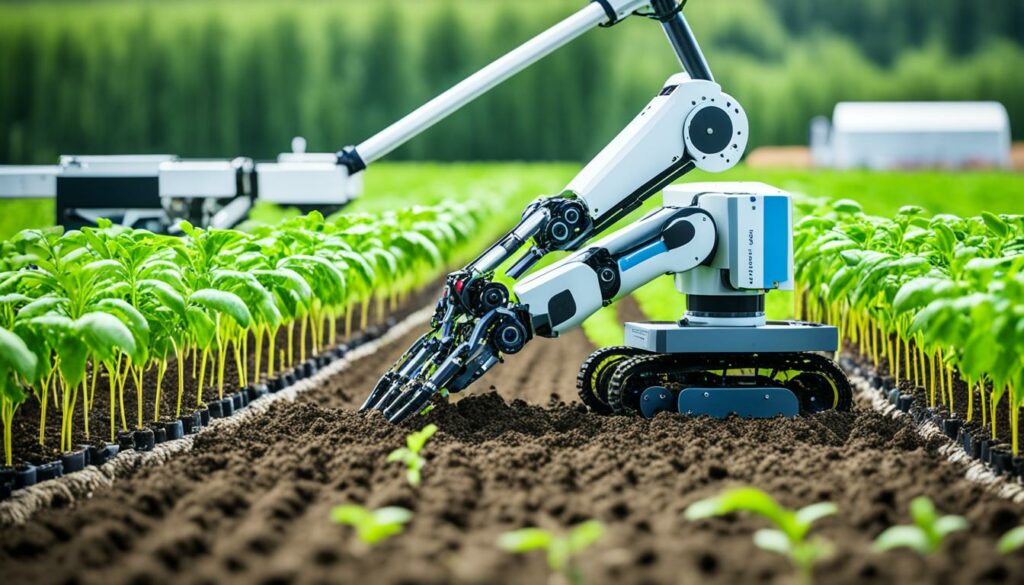
Modern farming relies heavily on data for decision making. Companies like Syngenta use drones to gather data for smart farming. For instance, analysing data from 6,000 fields has shown huge savings in time and money. This tech allows for actions that target problems directly, improving crop harvests and efficiency.
The use of data marks a powerful step towards full automation in farming. Though few farmers are on board with this high-tech approach yet, there are massive advantages waiting. Automation can cut labour costs and add major value, like saving $1.5 billion each year in the US corn sector. These steps forward are making the farming industry not just smarter but also stronger for the future.
Robotic greenhouses are leading a new phase in urban food growing. They use robotics and AI to cultivate crops in cities. This approach is both green and productive, changing how we look at farming in cities.
| Company | Technology | Efficiency |
|---|---|---|
| Bowery Farming | Robotic Greenhouses | 90-95% less water usage |
| AppHarvest | AI and Robotics | Increased crop yields with reduced water use |
| Iron Ox | Hydroponics System | 90% less water than traditional farming |
| Plenty | Indoor Robotic Farm | Uses a fraction of the water compared to traditional agriculture |
Robotic greenhouses mark a shift towards year-round food growth in cities. They carefully control the climate and use little water. This ensures we get fresh, pesticide-free food always.
Iron Ox uses unique hydroponics that cut water use by 90%. Bowery Farming reduces water use by 95% while still growing the same amount of food. These methods are key for feeding cities in a sustainable way.
AppHarvest leads in using AI and robots to grow more food efficiently. They want 70% of the US to have easy access to their fresh food. They show the big impact these greenhouses can have in urban areas.
Plenty’s farms need much less water than usual. They stand out for growing super clean, pesticide-free food. You can buy their greens at places like Whole Foods. Gelson’s sells them, too.
In these high-tech farms, everything is managed with great efficiency. They are in Compton, California. This spotlights growing food close to the people who live in cities.
Robotic greenhouses point to a bright future for urban agriculture. They offer better ways to be green, efficient, and to bring top-quality food to everyone.
Drone technology is changing how we farm. It’s giving farmers new ways to manage their crops better. Drones help monitor fields and apply treatments more efficiently.
Drones are great for checking on crops from the sky. They have special cameras and sensors that take detailed photos of large areas quickly. These photos show how healthy the soil is, what the crops look like, and where the fields need special attention. Companies such as DroneDeploy make it easy for farmers to spot problems like poor crop health or pests. Fast detection means farmers can act quickly. This smart use of technology boosts crop yields and saves time and money.
Drones are also being used to apply pesticides and fertilisers in a smarter way. Thanks to new rules, companies like Hylio fly heavy-duty drones in groups. A single operator can manage three of these drones to treat over 150 acres an hour. This efficient method cuts the need for lots of manual work and lowers labour costs. The drones make sure the chemicals are used only where they’re needed. This approach is better for the environment and supports sustainable farming.
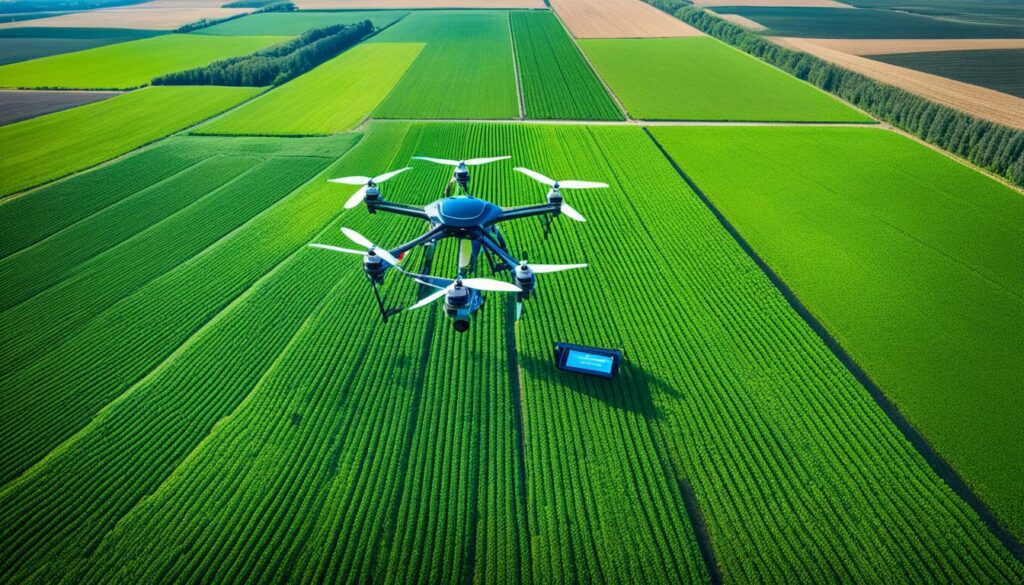
Drone technology’s impact on farming is clear at shows like the World Agriculture Expo. At the 2024 event in Tulare, California, the latest farming tools were on display. These tools included machines that spray crops on their own and robots that pick berries using AI. Drones, alongside other technologies, are leading farming towards a more efficient and sustainable future.
Farm robotics sound promising, but challenges exist. One problem is the high cost to get these technologies. This cost is too much for many farms, especially those in developing nations.
Another issue is the need for advanced skills to use and fix these robots. Not every farm worker knows how to handle them. This means more training for staff or hiring costly experts.
Robots can break down, causing significant farm problems. They might stop working because of a fault or a software issue. This downtime can lead to less produce being grown.
Then, there’s the matter of the outside world being unpredictable. Weather and terrain are not always robot-friendly. Even as tech gets better, robots can still struggle with nature’s curveballs.
The table showcases farm robotics’ top problems:
| Challenge | Description | Implication |
|---|---|---|
| High Initial Costs | Significant investment needed for procurement and installation | Financially prohibitive for many farmers |
| Technical Expertise | Requires specialised skill set for maintenance and management | Costs associated with training or hiring expert staff |
| Robotic Malfunction | Prone to mechanical or software failures | Potential for significant downtime or crop loss |
| Environmental Variables | Unpredictable weather and terrain | Limits operational efficiency and adaptability |
To use farm robotics well, we need to keep improving. There’s a lot to be done to tackle these problems. Doing so will make farm robotics a key part of future agriculture.
The impact of robot farming tech on the economy is huge. It shows how tech is changing money matters in farming. With the world’s population reaching around 9.7 billion by 2050, there will be a 70% more need for farm products. This means we must find new ways to meet these demands.
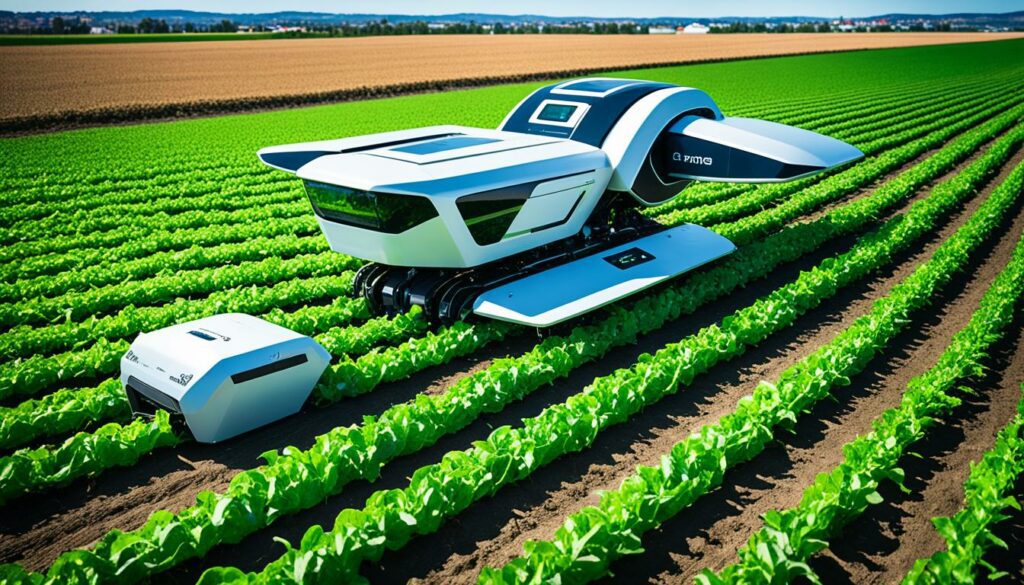
Looking at the costs and benefits of robot farming is eye-opening. The upfront costs are big, especially for poorer countries. However, these technologies can slash the cost of human labour. More than 50% of a farm’s costs go towards labour. And, with many farmers struggling to find workers, using robots makes economic sense.
Robots in farming can also improve how we use pesticides. They cut down pesticide use by up to 90%, which is great for our planet. For example, one strawberry-picking robot can do the work of 30 people in just three days. It can cover 25 acres during that time. This shows how much these new technologies can save on labour.
Robot farming also has many long-term benefits. It boosts how good and how much crops we grow by being very exact in its work. This positive economic change is more than just saving money. It also pushes farmers to grow crops that need less work but are worth more. 31% of farmers are already growing these kinds of crops because they can’t find enough workers.
What’s more, robot farming helps us use resources better and reduces waste. This means more profit. Although the first investment in these technologies can be tough, the money you save and earn later is worth it. It’s a sound economic plan for the future.
Agricultural robotics brings remarkable environmental benefits. It helps cut the usual ecological impact of farming. By using these advanced solutions, we promote a healthier environment.
The environmental benefits of agricultural robotics include less chemical usage. Small robots, with precise tech, can target spray biopesticides. They also use lasers to weed without harming good insects and plants. This approach helps keep our ecosystems diverse.
Using robotic farming helps make the best use of resources. Robots do jobs like spreading fertiliser and weeding efficiently. They keep farms healthy while using fewer resources. This cuts back on water use, soil pollution, and reduces the carbon footprint. It helps create a better environment for all.
Agricultural economist Thomas Daum talks about the big effect robots can have on farming’s future. He says it could lead to a very good or bad place. This path depends on new technology and the right policies. Luckily, sustainable robot farming offers a bright view. It helps smaller farms in Europe go greener, which is good for nature and farming.
Collaborative robots, known as ‘cobots’, are changing agriculture. They work alongside people, boosting productivity. In 2022, U.S. sales of these robots grew by 48%. They help by doing hard and repetitive work. This lets farmworkers focus on more complex tasks, making farms work better.
Cobots are a big help where there aren’t enough farm workers. They take on time-consuming jobs, cutting costs and meeting demands. They also help save on chemicals by only spraying where needed, making farming more eco-friendly.
Robotic farming is getting more advanced. Projects like AGROBOFOOD by Robotnik show future possibilities. The use of cobots is growing fast. It makes farming safer, more efficient, and greener.
In closing, agricultural robotics show a huge leap in farming’s future. They boost efficiency and help farms be more eco-friendly. This is crucial as the world’s population heads towards 9.7 billion by 2050. Such growth means we must increase food production while reducing its impact on the planet.
Robots in farming lower costs and cut down on the need for more workers. For example, robots that plant seeds and remove weeds can slash the use of harmful chemicals by 90%. They also help address the issue of not having enough people to work in farming. Today, many farms struggle to find workers.
Robotic systems can do big tasks, like harvesting strawberries, better than people. Just one robot can pick strawberries on a huge area in much less time than 30 workers. This shows how robots can majorly change farming for the better.
Also, these systems make farming kinder to the environment. They use less power and water, which helps meet green goals worldwide.
The market for farming robots is growing fast. By 2033, it might hit $86.5 billion from $13.4 billion in 2023. Even though it faces some challenges, many are working together to overcome them. This teamwork aims to bring more tailored and effective robotic solutions to farms.
Looking ahead, we see that agricultural robots will completely change how farming works. This change will make farms more able to withstand challenges while boosting output sustainably. Ultimately, it will help ensure there’s enough food for the world’s growing population.
Robotics are changing farming by making it more sustainable and efficient. They use technologies like harvesting robots and weeding robots. This helps improve how we farm.
Farm robotics make farming tasks more precise. They use robots that can sense and pick crops correctly. This cuts down on costs and helps produce better crops.
AI in farming offers smart tools for better farm management. It helps with things like predicting farm needs and choosing the right times to apply pesticides. This makes farming more efficient.
In farming, we usually see robots like those with six-axis arms for precise work. Mobile robots are great for checking crops and working in the fields. We also use autonomous tractors for planting and spreading fertiliser.
Harvesting robots pick crops with great care. They check if crops are ripe with sensors and cameras. This method is better than traditional ways because it’s gentle and efficient.
Weeding robots can spot and remove weeds without help. They cut out manual labour and lower herbicide use. This is a big change for big farms.
Robots for seeding and planting use GPS and sensors to plant seeds exactly right. This makes sure the seeds grow well. These robots make the planting of crops very even.
Robots are key in spreading fertiliser exactly where it’s needed. They stop waste and makes farms more sustainable. Thanks to them, farming can use resources better.
Mobile robots help check crops and move without help. They tell us things like soil moisture, which helps make decisions. These robots are part of making farming precise and efficient.
Autonomous tractors work around the clock without a break. They do jobs like ploughing very accurately. This makes farming more productive and increases the amount of crops grown.
Today, farming is focusing on being efficient and good for the planet. This means using big data and autonomous technology. These changes help farmers make smarter choices and do their jobs better.
Robotic greenhouses are changing how we grow food in cities. They use less water and are sustainable. By using sensors and new farming methods, they help bring fresh food closer to people in cities.
Drones are cutting-edge tools in farming. They help watch over crops and only use pesticides where it’s really needed. This means healthier plants, less waste, and a bigger harvest.
Farm robots do face some hurdles like high costs and needing skilled people to look after them. There are also issues when the robots don’t work right and in dealing with the many changes of nature.
Robots in farming save money in the long run by doing tasks faster and better. Even though they cost a lot to start with, their benefits over time are worth it. They make businesses bigger and more successful.
Robotic farming is good for the earth in many ways. It means less chemicals, saving water, and protecting the soil and air. It’s a big step towards a friendlier planet.
Collaborative robots, or ‘cobots’, help with hard and boring jobs. They make workers less tired and let them do important jobs. This makes the whole farm team happier with their work.